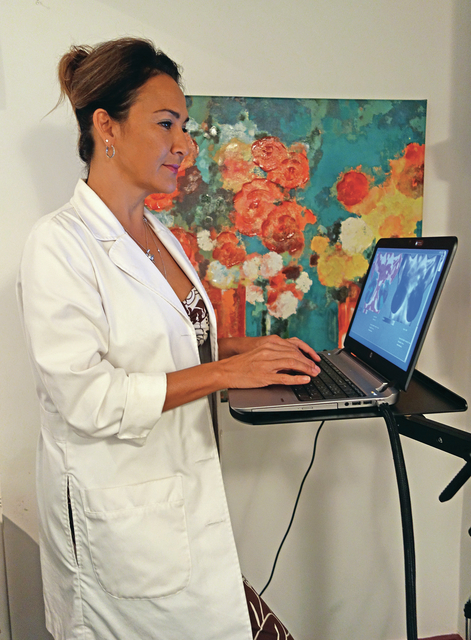WAIMEA — October has long been known as Breast Cancer Awareness month. More recently the campaign has expanded to include Breast Health Awareness, with a focus on overall breast health and advanced technologies for prevention and detection that are available
WAIMEA — October has long been known as Breast Cancer Awareness month. More recently the campaign has expanded to include Breast Health Awareness, with a focus on overall breast health and advanced technologies for prevention and detection that are available year round.
A less known but well documented and researched technology that women are newly discovering is infrared breast thermography. Compared to mammography, thermography is non-invasive and doesn’t hurt or harm the body because there is no radiation involved. And because thermal imaging can detect changes at a cellular level, studies suggest it can detect breast cancer indicators five to eight years earlier than any other test, including mammography.
Dr. Valerie Quijano offers medical thermal imaging, including breast thermography, at her Waimea office.
“Unlike other forms of imaging which detect structural changes, such as a tumor, thermography looks at the body’s subtle neurochemical signals, which appear far in advance of significant damage to the body,” she said.
Dr. Quijano is board certified in clinical thermography and currently serves on the board for the International Association of Certified Thermologists. She has been performing thermal imaging on the Big Island since 2012 and is currently the only thermal imaging provider on the island.
A personal health scare led her to thermography originally.
“In 1992, my gynecologist discovered a lump in my breast,” Dr. Quijano said. “Of course I was shocked and worried, and wasn’t sure what to do.”
Her MD recommended a mammogram but Dr. Quijano was turned off after reviewing brochures and literature on its effects.
“I decided there was no way I would subject my breast to ionizing radiation and painful compression,” she said.
Her chiropractor suggested medical infrared imaging, which led Dr. Quijano to thermograms that she has taken for the past 24 years.
Because the initial thermogram showed questionable findings, she repeated the breast imaging six months later. The findings were identical so she continued to re-examine annually. But in 2012, Dr. Quijano received an abnormal result. She re-evaluated her food and lifestyle habits and developed a True-Health Program she follows and now offers her clients.
“In six months I was back to normal,” Dr. Quijano said. “My lifestyle changes reversed the inflammation in my breasts.”
Perhaps the most promising aspect of thermography is its ability to spot anomalies years before mammography.
“Regardless of your family history, if a thermogram is abnormal you run a future risk of breast cancer that is 10 times higher than a first-order family history of the disease,” she noted.
Thermography works on the widely accepted principle that all cancers, even in their earliest stages, need nutrients to maintain or accelerate their growth. To facilitate that process, blood vessels are caused to remain open, inactive blood vessels are activated and new blood vessels are formed through a process known as angiogenesis. This vascular process causes an increase in surface temperature in the affected regions which can be viewed with infrared imaging cameras.
Thermography provides an individualized breast cancer assessment so that if certain thermographic risk markers are discovered, it can warn a woman that she needs to work closely with her doctor with regular checkups to monitor her breast health.
The thermography process begins with the patient entering a special temperature-controlled room. After waiting for a brief period while the body acclimates to the prescribed temperature of the room, the patient then stands in front of a medical-grade, highly sensitive digital infrared camera. Computerized images are taken that show the body’s natural internal heat patterns — thermal energy as a result of metabolism. The images are then reviewed by a certified thermographic interpreter using a four-part analytical method and results are reviewed with the patient.
If questionable thermographic signals are detected, Dr. Quijano can discuss dietary and lifestyles changes with the patient to help normalize the imbalances. Her True-Health Program evaluates adrenaline, cortisol and insulin function. With thermography as a regular screening tool, it’s likely that adjustments to diet, beliefs and lifestyle could transform cells before they become cancerous.
Adding to her expertise, Dr. Quijano is also a chiropractor and an eating psychology practitioner. She developed and served as director of the Medical Wellness Center of Hawaii from 2010-2013 and has completed certifications in medical weight management and anti-aging medicine. In Dr. Quijano’s practice, the use of thermal imaging has also detected hormone imbalances, thyroid issues, chronic tooth infections, low-grade chronic sinus infections, carotid artery inflammation and muscular skeletal issues.
Currently, she is working closely with Waimea gynecologist Dr. Jade McGaff to provide patients with individualized health care programs, including an all-inclusive breast health/sexual health care program. Dr. McGaff provides bio-identical hormone replacement therapy, MonaLisa Touch Laser therapy and other gynecological needs.
Dr. Quijano recently upgraded her imaging equipment and is offering a $100 discount throughout December.
Info: 756-8611 or valerie.quijano@gmail.com



